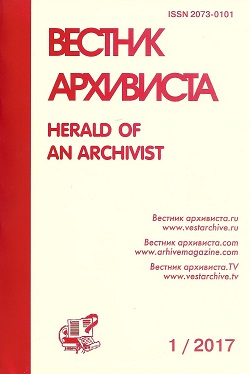Scientific article
УДК 94(47).083+929.82–94+94(470)
DOI 10.28995/2073-0101-2022-1-229-241
Belova, Irina B.
K. E. Tsiolkovsky Kaluga State University, Kaluga, Russian Federation
“The Human Waves”: F. A. Kudrinsky’s Diary Entries about the Refugees of the First World War (1915)
Abstract
The article is devoted to the events of summer-autumn 1915, as reflected in the diary of Fedot A. Kudrinsky, teacher of the Vilna gymnasium, who became a refugee and got settled in the city of Rogachev, Mogilev gubernia. Kudrinsky's diaries tell of mass refugee movement from the territories controlled by the North-Western Front coming through the uezd town of Rogachev, which became one of the refugees’ centers. The author was in Rogachev on official business in July 1915, prior to mass movement of refugees further into the empire. At that time, he witnessed a week-long stay of German colonists of Russian citizenship who had been deported by the military authorities from the front line to the Chernigov gubernia. They moved on carts hired at the state expense, accompanied by mounted guards, making stops on the way to change horses. Kudrinsky describes their life and customs, their pro-German moods, and negative attitude towards authorities. He also records the appearance of the very first refugees in Rogachev in April 1915: families of employees from the Kovno gubernia arrived in the city, having fled hastily from the Germans. The attitude of the local population and authorities to them is shown. Though a representative of local administration and executive authorities, Kudrinsky learned in mid-July 1915 that at least 65 000 refugees were to be sent through Rogachev. However, in 1915, about 700 000 refugees heading in an easterly direction were registered in Rogachev. By August 1915, the refugee movement grew to mass proportions. Residents of the Kholm and Lublin gibernias followed their horse-drawn route from Bobruisk through Rogachev. To move further, it was necessary to cross the Dnieper in Rogachev by ferry (due to the lack of bridges along its entire length from Mogilev to Kiev). For this reason, the small town Rogachev was overcrowded with horse-drawn transport. However, by late August, the problem was solved with the opening of two new bridges at once, and the streets became less crowded. Kudrinsky details the appearance of the refugees and everything inside their carts. He outlines the appearance and road moods of the residents of different gubernias. In his interactions with the refugees, Kudrinsky learned, among other things, that peasants did rob the noble estates on the way, never considering it shameful because of the military disaster. While waiting to be sent by rail, refugees lived in Rogachev, on the territory assigned to them, up to several weeks, building tents of wooden shields and cooking food on bonfires that burned day and night. They also went to the feeding stations, although not regularly as there were long queues. As the author witnessed first-hand, there was no strict control over admission to the station of only those who had received “receipts” for departure, nor over boarding the cars. By late September, the refugees were no longer sent through Rogachev. In the second decade of October, they became noticeably fewer in the city. Those who remained moved to barracks and dugouts. The feeding stations were able to distribute food much faster. By the evening of October 20, all the refugees had left Rogachev for interior regions of the empire by rail. Meanwhile, on November 12, new refugee carts appeared in large numbers on the streets of the city coming from the Novogrudok uezd of the Minsk gubernia. They were to be sent from Rogachev to the interior regions. The refugees had already been resettled twice within the territories controlled by the military authorities. Finally, it was deemed expedient to send them to the rear, and now they had to move to yet another place of temporary residence until the end of the war. Despite the arrival of this last large batch of refugees in Rogachev, the mass refugee movement, according to Kudrinsky, had dried up by early November.
Keywords
Historical source, F. A. Kudrinsky’s diary, Belarusian and Polish refugees of the First World War, German colonists, Rogachev city, Mogilev gubernia, evacuation, appearance and life of refugees, refugee camp.
Download the article: belova_doi
References
BELOVA, I. B. “Zapiski o proshlom” E. A. Nikol'skogo kak istochnik po izucheniyu problemy bezhenstva Pervoi mirovoi voiny [“Notes on the Past” of E. A. Nikolsky as a Source for Studying World War I Refugees. In Russ.]. IN: Vestnik arhivista / Herald of an Archivist, 2020, no. 1, pp. 59-71. doi 10.28995/2073-0101-2020-1-59-71
CHERNYAKEVICH, A. “Kronika poszukiwania straconej Ojczyzny”: do?wiadczenie powrotu z uchod?stwa w ?wietele dziennika Piotra Sieruka [Chronicle of the search for the lost Homeland: The experience of returning from refugees in the light of Peter Sevruk's diary. In Pol.]. IN: Wojna i ludzie. Spoleczne aspekty I wojny swiatowej w europie wschodniej. Otv. red. Dorota Michaluk. [MICHALUK D. (ed.). War and people. Social aspects of World War I in Eastern Europe. In Pol.]. Ciechanowiec, Muzeum Rolnictwa w Ciechanowcu publ., 2015, pp. 319–327.
PRYMAKA-ONISZK, A. Bezhenstvo 1915. Zabytye bezhency [Refugee 1915. Forgotten Refugees. In Pol.]. Wo?owiec, Wydawnictwo Czarne publ., 2016, 367 p.
About the authors
Belova Irina Borisovna, PhD in History, associate professor, K. E. Tsiolkovsky Kaluga State University, department of history, professor, +7-905-640-51-43, This e-mail address is being protected from spambots. You need JavaScript enabled to view it
Submitted 10.06.2021, published (for citation):
BELOVA, I. B. “Lyudskie volny”: dnevnikovye zapisi F. A. Kudrinskogo o bezhentsakh Pervoi mirovoi voiny. 1915 g. [“The Human Waves”: F. A. Kudrinsky’s Diary Entries about the Refugees of the First World War (1915). In Russ.]. IN: Vestnik arhivista / Herald of an Archivist, 2022, no. 1, pp. 229-241. doi 10.28995/2073-0101-2022-1-229-241














